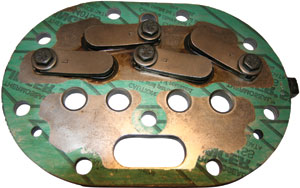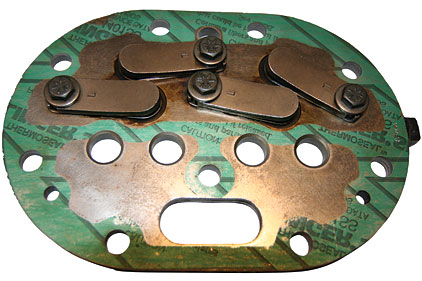
|
| Figure 1. Back of compressor discharge valve. (Photo courtesy Ferris State University) |
The compressor’s superheated discharge temperature can be measured by placing an insulated thermistor or thermocouple on the discharge line about 3 to 4 inches from the compressor. Today’s technology allows service technicians to use an infrared-temperature-sensing device that can be purchased at a reasonable price. The compressor’s discharge temperature is a measure of the superheated refrigerants vapor temperature. Since the compressor’s discharge temperature is a superheated vapor temperature measurement, a pressure/temperature relationship does not exist, and a pressure gauge cannot be used for its measurement.
Pressure gauges can only be used for a pressure/temperature relationship when a saturation temperature (evaporating and/or condensing temperature) is needed. Since the compressor’s discharge temperature is a reflection of what is going on inside the compressor, it must be monitored very closely. The back of the compressor’s discharge valve (Figure 1) is actually the hottest part of the system, but it is impossible to measure by a service technician. The next closest place, however, is the discharge line of the compressor.
The limit to any compressor discharge temperature is 225˚F. If the discharge temperature gets higher than 225˚F, the system may start to fail from worn rings, acid formations, and oil breakdown. Remember, if the discharge temperature is 225˚F, the back of the actual discharge valve will be about 75˚F hotter. This will bring the actual compressor’s discharge valve to 300˚F. It is a known fact that most oil may start to break down and vaporize at 350˚F. If this occurs, serious overheating problems will occur. And, since compressor overheating problems are today’s most serious causes for compressor overheating, HVACR service technicians must always monitor compressor discharge temperatures and keep them under 225˚F.
Some main reasons for high compressor discharge temperatures are high-condensing pressures, low-suction pressures, high-compression ratios, and high-compressor superheats.
High-Condensing Pressures
Here are some causes for high-condensing pressures:
• Dirty condenser coils;
• Burned out condenser fan motor;
• Broken condenser fan belts;
• Undersized condenser coils;
• Overcharge of refrigerant;
• Non-condensables in the system;
• High ambient temperature;
• Recirculated air over the condenser; and
• Mixed or wrong refrigerant.
A high-condensing temperature causes a high-condensing pressure. Now the compressor must put in more work, thus generate more heat of compression, in compressing the suction pressure to the higher-condensing pressures.
Low-Suction Pressure
Here are some causes for low-suction pressure:
• TXV or capillary tubes underfeeding;
• Low evaporator heat loads;
• End of the cycle;
• Temperature set point set too low;
• Frosted evaporator coils;
• Defrost clock motor burned out;
• Defrost heater burned out causing iced coils;
• Inappropriate defrost schedules;
• Evaporator fan motor out;
• Kinked suction lines;
• Dirty or plugged suction line filter;
• Dirty or plugged liquid line filter/drier;
• Linked liquid lines; and
• Plugged compressor inlet screens .
Again, more work, thus more heat of compression will be generated in compressing a lower suction pressure to the condensing pressure.
High-Compression Ratios
High-compression ratios can be caused from either low-suction pressures or high-head pressures — or both. The higher the compression ratio, the higher the compressor’s discharge temperature will be. This happens because more heat of compression will be generated when compressing the gases through a greater pressure range.
High-Compressor Superheats
High-compressor superheats can be caused from the evaporator being starved of refrigerant. This can happen with a restricted liquid line, undercharge, plugged filter drier, kinked liquid line, or TXV or capillary tube underfeeding.
Conclusion
In conclusion, compressor discharge temperatures reflect:
• All of the latent heat absorbed in the evaporator;
• The evaporator superheat;
• Suction-line superheat;
• Heat of compression; and
• Motor heat generated by the compressor.
It is at the compressor’s superheated discharge temperature where all of this heat is accumulated and now must start to be rejected in the discharge line, condenser, and liquid line.
Publication date: 1/14/2013



Report Abusive Comment